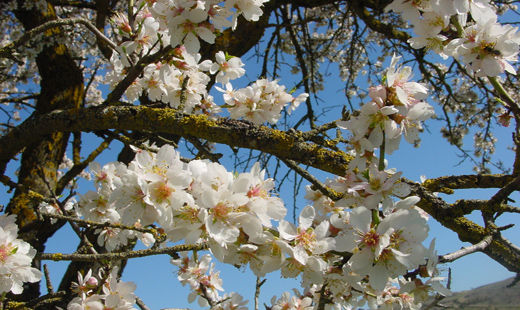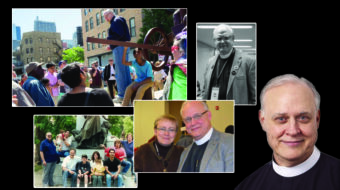
Ancient sages of the Jewish religion established a special new year for trees. Yes, trees! The New Year of the Trees in 2015 begins on the evening of Feb. 3 (the Jewish day runs from sundown to sundown). It’s called Tu b’Shvat, meaning the Full Moon (15th day) of the midwinter lunar month of Shvat. The holiday occurs just as the days are starting to lengthen, the life-juice begins to rise again in many trees, and a few begin to blossom, and represents not just the rebirth day of trees in general but of the divine Tree of Life itself.
This Jewish holiday had long fallen into obscurity, or at best a minimal observance consisting of distributing little packets of tree fruit and nuts to children. But in more recent times Jewish environmentalists have seized on this day to symbolize a greater identification with the fate of the Earth.
Just as the Passover Seder meal in the spring celebrates the liberation from slavery, a special Seder has emerged for Tu b’Shvat as the meal of the Garden of Eden. This repast comprises fruit and nuts that do not require the killing of any creature, not even a carrot or radish yanked up by its root from the earth. Around the world, Tu b’Shvat has been restored to the modern Jewish repertory of “politically correct” observances.
Rabbi Arthur Waskow of Philadelphia’s Shalom Center, has devised a hagadah, a book of readings, for use during the Tu b’Shvat Seder. It focuses on major policy questions facing the human race in the midst of a great climate crisis and massive extinctions of species. In successive sections of the meal there are traditional, mystical, musical, and poetical passages, as well as contemporary quotations on four major aspects of concern: Earth (food and forest); Water (fracking and pollution); Air (climate); and Fire (alternative and renewable energy sources). Discussion among participants is strongly encouraged.
One small example of the content of the hagadah is an old African-American spiritual retooled for the environmental movement:
We’ve got the whole world in our hands.
We’ve got the rivers and the mountains in our hands.
We’ve got the trees and the tigers in our hands.
We’ve got the whole world in our hands.
We’ve got the wind and the oceans in our hands.
We’ve got our sisters and our brothers in our hands.
We’ve got our children and their children in our hands.
We’ve got the whole world in our hands!
Jewish tradition (Leviticus 25: 4, 23) mandates that every seventh year there shall be a “Sabbath” for the land, a one-year pause for replenishment, a break from overcultivation. “Your field you are not to sow; your vineyard you are not to prune.” As an early culture of farmers and herders, the Hebrews learned the value of giving the land a rest. In a passage adapted from “The Gift of the Good Land,” American writer Wendell Berry says, “Agribusiness does not love the land. It treats soil as a raw material to use up. The result of the exploitation of the soil is soil erosion, soil compaction, soil and water pollution, pests and disease due to monoculture, depopulation of the country, decivilization of the city.”
If the Bible teaches good stewardship of the Earth, companies like Monsanto – that impose genetically modified crops on more and more farms that also require 25 percent more herbicides than farmers need with traditional seeds – threaten the whole principle of sustainability. Modern agriculture uses far larger quantities of water and fossil fuels than traditional farming.
An ideal holiday for vegetarians
Tu b’Shvat has also become the self-evident Jewish vegetarian holiday. Vegetarians say that a shift toward plant-based diets is essential, and like to cite the 2009 cover article in World Watch magazine, “Livestock and Climate Change,” by two environmentalists associated with the World Bank, who argue that the livestock sector is responsible for at least 51 percent of all human-induced greenhouse gases. This is largely due to the massive destruction of tropical rain forests and old growth forests to produce pasture land and land to grow feed crops for animals and the emission of methane from farmed animals. As a result, thousands of creatures are at risk of extinction.
Many progressive Jewish organizations, such as the Central Conference of American Rabbis, have issued calls to their constituents to recycle what can be repurposed; use for all construction only wood certified as sustainably harvested; divest from corporations whose activities contribute to the destruction of forests; strengthen government regulation and environmental study; and dedicate time, such as Tu b’Shvat and the autumn harvest festival of Sukkot, to learning about environmental issues and Jewish ethics.
While there is no single prescribed Tu b’Shvat Seder meal beyond tree fruits and nuts, it may also include the foods that are mentioned in Deuteronomy 8: 7-9, which refers to “a land of wheat, and barley, and vines, and fig trees, and pomegranates; a land of olive oil, and honey; a land in which you shall eat bread without scarceness.”
Trees in whose homeland?
The more than century-old Zionist project to establish a Jewish homeland in Israel has for many years been accompanied by a vigorous campaign to plant trees in Israel, to provide food, shade, and vegetation to halt the desertification that comes with climate change and a growing population. In recent years Jewish peace and solidarity activists, including rabbis and future rabbis and cantors studying in Israel, have taken part in human rights projects involving trees. They have worked alongside Palestinian families to plant trees at the Tent of Nations, a Palestinian family farm where the Israeli government has bulldozed fruit trees.
Jews seeking fair answers to the Israel/Palestine conflict have expressed outrage at Jewish settlers on Palestinian lands, and at the Israeli government itself, who over a span of many years have adopted policies of uprooting, burning, cutting down or poisoning Palestinian trees. New plantings have been torn from the soil, and mature trees providing a livelihood to families have been destroyed. In other cases, the high separation wall has divided Palestinian farmers’ homes from their orchards. Since 2001, Rabbis for Human Rights, alongside other progressive Jews, have been showing a different face of Judaism by planting trees both in areas where trees have been destroyed, and in areas where the presence of trees might help prevent those lands from being taken over.
You will find a version of the hagadah for Tu b’Shvat here that addresses how to heal the wounds that Mother Earth is suffering in our own generation. Rabbi Arthur Waskow of The Shalom Center adapted it in large part from one shaped by Ellen Bernstein, as published in “Trees, Earth, and Torah: A Tu B’Shvat Anthology.” (This article for People’s World is itself derived in part from these writings.) If you’re interested in possibly attending a Tu b’Shvat Seder, ask a local temple, synagogue or Jewish community center if they can direct you to one, or maybe find it through an online search.
Photo: Almond tree in blossom on Tu b’Shvat. | Wikipedia (CC)

MOST POPULAR TODAY


Zionist organizations leading campaign to stop ceasefire resolutions in D.C. area

Communist Karol Cariola elected president of Chile’s legislature

High Court essentially bans demonstrations, freedom of assembly in Deep South

Afghanistan’s socialist years: The promising future killed off by U.S. imperialism






Comments